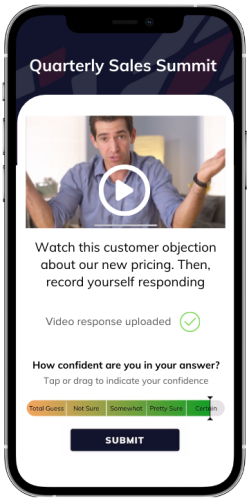November 2020 marked a milestone in the worldwide workforce.
Mobile usage surpassed desktop usage, capturing 53% of the global market share, while desktop dropped to 44%.
Mobile devices are no longer strictly for communication and personal use. Today, employees rely on smartphones and tablets to collaborate, access company information, and work using company apps.
For sales reps, the right training can make the difference between success and failure. And what tool do sales reps already have at their fingertips? Mobile devices. Training your team on their phones equips them with searchable, always up-to-date sales content and lessons. Mobile learning gives your team the information and resources they need to move deals down the pipeline quickly and efficiently.
What is Mobile Learning?
The Mobile Learning approach, also called M-learning or mLearning, allows learners to access materials and lessons anytime and anywhere. Learners can move through training content on any device (usually their smartphone, but they can also access it via tablet or desktop if they prefer.
Users can access, complete, and master new concepts on mobile without committing to scheduled in-person meetings. Over 67% of US companies offer mobile learning opportunities, increasing user engagement and creating more capable employees.
But why has mobile learning taken the Learning and Development (L&D) industry by storm? What are its benefits over traditional models of training? How can you use a smartphone — the ultimate ‘distraction device’ – to actually increase productivity and knowledge retention?

The Shift in Learning Patterns
Previous modes of training can be too long and inconvenience your employees. If your goal is to improve sales performance, it’s hard to justify long training sessions, especially when training requires taking employees out of the field. Long training sessions lead to boredom, confusion, and frustration – all of which encourage employees to tune out and think about other things.
58% of employees would be more likely to use their company’s online training tools if the content was broken up into multiple shorter lessons. The modern learner wants learning to be a media-rich experience that incorporates a variety of formats: podcasts, videos, images, and even interactive elements. They want to fit learning into their daily schedule, wherever and whenever best suits them.
Why Is Mobile Learning Important?
Businesses are competing in an incredibly tight labor market. This makes it important for companies to engage their employees by allowing them to evolve with the company. In a labor market where positions can go unfilled for months, smart companies understand that training, rather than hiring, is the way to develop the talent they need.
It’s Accessible
The workspace has never been more global as remote and hybrid work positions continue to rise in number. Employees are now able to take their work on the go and they need training resources that match this adaptability.
Mobile learning makes it easy to train alongside teammates no matter where they’re located. When you have teams that span multiple offices (and sometimes even multiple continents), you need mobile learning to get the best out of your team.
Mobile learning modules are designed specifically for the device learners have with them at all times. As a result, lessons and content are always available, regardless of where the learner is.
Through mobile learning, an organization makes content available 24/7. Issues like time zone differences or distance are no longer hindrances, which is vital for an increasingly global workforce. And since 89% of employees want training available anywhere and anytime they need to do their job, mobile learning helps fulfill these wants and needs.
Higher Engagement
A significant advantage of mobile learning is personalization. Tailor-made learning modules promote a higher rate of engagement and motivation for learners through interactive and gamified experiences.
A gamified mobile learning experience requires users to participate actively in the training process. This style of active learning encourages self-directed learning at a time and place that best suits your learners.
Mobile platforms will typically also give learners feedback wherever possible. For example, a learner who submits an incorrect answer on a quiz receives instant and constructive feedback, making it more likely that they will retain the concept. The learner feels supported in their training, while the trainer receives crucial data to better understand their employee’s knowledge gaps.
Fast and Efficient
There is nothing more frustrating than training a group of employees only to find they’ve forgotten how to perform a task the next day. However, this lack of retention may not be the fault of your learners. The problem could be your training length and style.
After one hour, people retain less than half of the information presented in a training session. Long sessions of lectures and PowerPoint presentations tend to disengage the learners, especially when the material is not immediately applicable to their work.
Most mobile learning approaches deliver information to employees in bite-size chunks. Small bits of information accelerate learning by avoiding cognitive overload. Training takes place in concise, 2-5 minute bursts. As a result, mobile learners complete courses 45% faster than their desktop counterparts.
Cost-Effective
Think about how much you’re currently spending on off-site workshops and other live, in-person training formats.
When you factor in instructor fees, travel expenses, gas, food, lodging, material costs, etc., you realize that these training sessions can get very expensive, very fast.
With mobile learning, you’re offering your team an easy way to train that’s inexpensive, easily accessible, and lets learners complete courses on their own schedule.
Provides Crucial Data
Learners aren’t the only employees who benefit from mobile learning. The best mobile learning platforms make analytics and performance dashboards available to trainers, administrators, and employees.
The data generated from those assessments helps track where employees are succeeding. They make it easy to target remediation training on the concepts that people don’t understand.
Potential Downsides of Mobile Learning
While mobile learning has many compelling strengths, there are potential disadvantages to this approach. A successful mobile training program needs to be designed in a way that diminishes the following challenges.
Hardware Issues
Software constantly upgrades and changes based on the needs of consumers. However, physical hardware is susceptible to the long-term effects of wear and tear. Working on an outdated or damaged device can hinder the effectiveness of a mobile learning course.
To mitigate this risk, effective mobile learning programs are designed with cross-device functionality. If a learner buys a new smartphone, they can continue training on the new device exactly where they left off. And if they prefer, they can switch to learning on a tablet or PC.
Mobile learning done right should meet learners where they are, providing access to content no matter the circumstances.
Distractions
One of the largest issues across all eLearning platforms is distractions. When we work on a smartphone, we expose ourselves to a constant stream of distractions: phone calls, email alerts, and social media notifications. It’s easy to picture a trainee focusing on their course, only to be pulled away by the sudden PING of a text message.
Effective mobile learning acknowledges these distractions. That’s why learning modules should be no longer than 5-7 minutes.
Shoehorning an hour-long training into a mobile learning platform is a recipe for disaster, but a platform that breaks learning into small chunks of key concepts helps learners complete training between distractions.
Lack of Internet Connectivity
The beauty of mobile learning is that employees can uplevel their skills anytime and anywhere. However, in some remote settings without a strong internet connection, it can be hard for learners to access training content.
As access to affordable mobile internet connections increases worldwide, this is less and less of a challenge. However, when designing your learning resources, every leader should consider their team’s access to the internet.
What to Look for In a Mobile Learning Platform
Not all mobile learning platforms are created equal. Having a set of ‘must-haves’ when choosing how to implement mobile learning will greatly benefit your team’s training success. A few options worth considering include:
Gamification
Games have become one of the most effective ways to increase learner engagement. As of 2019, 46% of internet users aged 23-36 would consider themselves casual gamers.
The numbers point to the possibilities of gamification as an essential e-learning tool. Consider using point systems, leaderboards, or game badges within your training program.
Fast and Easy Creation
Mobile learning sounds great in theory. However, it’s hard to realize those benefits if creating lessons is a heavy lift. For instance, if it takes a long time to build a fresh lesson, or if lesson creators need significant technical training, then your learning cycles will slow to a crawl.
Choose a platform that is simple and intuitive for anyone to build learning modules – even team members without strong technical backgrounds.
Microlearning
Microlearning is a way of teaching content to learners in small and very specific nuggets or micro bites. Microlearning, alongside a mobile learning strategy, allows for greater flexibility in your learners’ schedules.
Employees can access a microlearning session right on their smartphones at any time and confidently complete the short segments of training without the anxiety of being rushed.
Actionable Analytics
Creating an easily accessible and completable lesson for your employees is a great benefit for them. The real benefit for you rests in the valuable analytics lesson assessments can provide.
Great mobile learning platforms provide administrators with data on employee performance, allowing them to then identify knowledge gaps and create subsequent lessons to address this need.
Is Mobile Learning Right For You?
Mobile learning helps your team adapt to the changing world by offering an easy way to stay, accelerate their learning and increase their performance. Every organization can benefit from faster learning cycles. Implemented correctly, mobile learning can dramatically improve performance.
If you’re looking for a cost-effective way to improve company performance, make training more engaging, and boost knowledge retention, mobile learning should be a core element of your strategy.
At Learn to Win, we’ve built a mobile-first learning software that makes it easy for any team to learn quickly on-the-fly. We first developed the software as a mobile learning tool to help football teams master their playbooks. Now, our platform makes it simple for anyone to build training that helps their teams get better, faster.
Want to learn more about how Learn to Win can help your training keep up with your business? Request a demo today!

